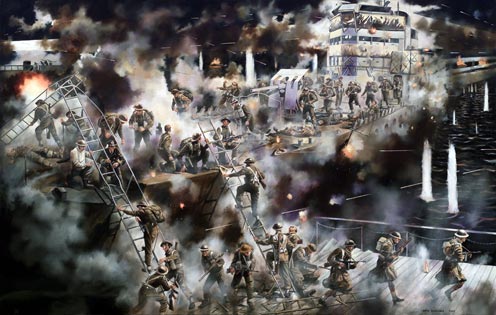Blog
Following Remembrance weekend, Denise Orzel, daughter of Private Bill "Dutch" Holland, a commando who had participated in Operation Chariot visited the museum with her family. Denise has loaned the museum a fascinating print by the artist David Rowlands which depicts the raid by the British army commandos on St Nazaire in March 1942. The limited edition print signed by the artist is currently on display in our commando exhibition. The original oil on canvas painted in 2002 is in the National Army Museum's collection. Here, Thierry Guihéneuf, who is a native of Saint-Nazaire, tells us more about the raid.

On 28 March 1942, a daring amphibious operation led by Royal Navy ships and British army commandos with the support of the Royal Air Force, stormed the port of Saint-Nazaire in south Brittany, France to put out of action the only dry dock on the Atlantic coast capable of hosting the mighty German battleship Tirpitz. HMS Campbeltown, an old American destroyer disguised as a German counter-torpedo ship, managed to ram the south caisson-gate of the Normandie dock at 1:34am, only four minutes behind schedule, and unload her commandos whose objective was to destroy the port installations operating the dry dock. The ship was part of an attack flotilla comprised of a Motor Gun Boat (MGB 314) acting as command ship, a Motor Torpedo Boat (MTB 74) carrying two delayed action torpedoes for backup, and fifteen wooden Motor Launches (MLs) whose role was to draw enemy fire away from the destroyer, carry the remainder of the commandos ashore, and withdraw the landed troops from a jetty known as the Old Mole once their objectives had been fulfilled.
HMS Campbeltown was more than just a ramming ship as she was loaded with more than 3.3 tons of Amatol hidden in her bow. The ship exploded some nine hours after she rammed the south caisson-gate of the Normandie dry dock. The explosion of HMS Campbeltown together with the remarkable work carried out by the commando demolition parties caused so much damage that the dry dock would not be operational again until the war was over. This mission known as Operation Chariot was overseen by Lord Louis Mountbatten, chief of Combined Operations and later remembered as “The Greatest Raid of All”. Its strategic impact was so significant that the Tirpitz would never dare to venture into the Atlantic and cause havoc amongst the Allied convoys.
The price to pay for such a daring raid was high, however. One of the tragedies of the Raid, beside the significant loss of lives, was the tactical failure of the MLs to land at the Old Mole and establish a bridgehead after so many landing crafts were knocked out at close range on the approach to the Estuary. Amongst the Commonwealth forces involved in the Raid, more than one third of the commandos and Royal Navy personnel were taken prisoner. Of the Army Commandos who were volunteers initially trained in Scotland and especially in the Highlands, only five commandos managed to escape from Saint-Nazaire and reach Gibraltar.
Thierry Guihéneuf











